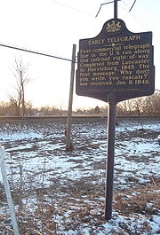
Electrical telegraph
Overview
An electrical telegraph is a telegraph
that uses electrical signals, usually conveyed via telecommunication lines
or radio
. The electromagnetic telegraph is a device
for human-to-human transmission
of coded text message
s.
The electrical telegraph, or more commonly just 'telegraph', superseded optical semaphore telegraph systems, such as those designed by Claude Chappe for the French military, and Friedrich Clemens Gerke
for the Prussian military
, thus becoming the first form of electrical telecommunication
s.
Telegraphy
Telegraphy is the long-distance transmission of messages via some form of signalling technology. Telegraphy requires messages to be converted to a code which is known to both sender and receiver...
that uses electrical signals, usually conveyed via telecommunication lines
Channel (communications)
In telecommunications and computer networking, a communication channel, or channel, refers either to a physical transmission medium such as a wire, or to a logical connection over a multiplexed medium such as a radio channel...
or radio
Radio
Radio is the transmission of signals through free space by modulation of electromagnetic waves with frequencies below those of visible light. Electromagnetic radiation travels by means of oscillating electromagnetic fields that pass through the air and the vacuum of space...
. The electromagnetic telegraph is a device
Machine
A machine manages power to accomplish a task, examples include, a mechanical system, a computing system, an electronic system, and a molecular machine. In common usage, the meaning is that of a device having parts that perform or assist in performing any type of work...
for human-to-human transmission
Transmission (telecommunications)
Transmission, in telecommunications, is the process of sending, propagating and receiving an analogue or digital information signal over a physical point-to-point or point-to-multipoint transmission medium, either wired, optical fiber or wireless...
of coded text message
Message
A message in its most general meaning is an object of communication. It is a vessel which provides information. Yet, it can also be this information. Therefore, its meaning is dependent upon the context in which it is used; the term may apply to both the information and its form...
s.
The electrical telegraph, or more commonly just 'telegraph', superseded optical semaphore telegraph systems, such as those designed by Claude Chappe for the French military, and Friedrich Clemens Gerke
Friedrich Clemens Gerke
Friedrich Clemens Gerke was a German writer, journalist, musician and pioneer of telegraphy who revised the Morse code in 1848. It is Gerke's notation which is used today.-Life:...
for the Prussian military
Prussian semaphore system
The Prussian Semaphore System was a telegraphic communications system used between Berlin and the Rhine Province from 1832 to 1849. It could transmit administrative and military messages by optical signal over a distance of nearly . The telegraph line comprised 62 stations each furnished with a...
, thus becoming the first form of electrical telecommunication
Telecommunication
Telecommunication is the transmission of information over significant distances to communicate. In earlier times, telecommunications involved the use of visual signals, such as beacons, smoke signals, semaphore telegraphs, signal flags, and optical heliographs, or audio messages via coded...
s.
Unanswered Questions

